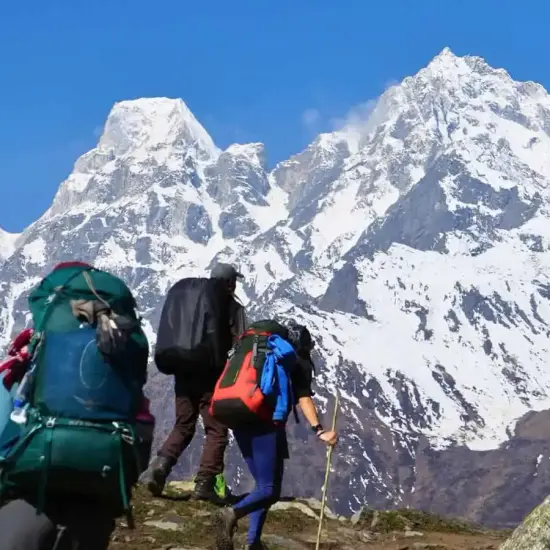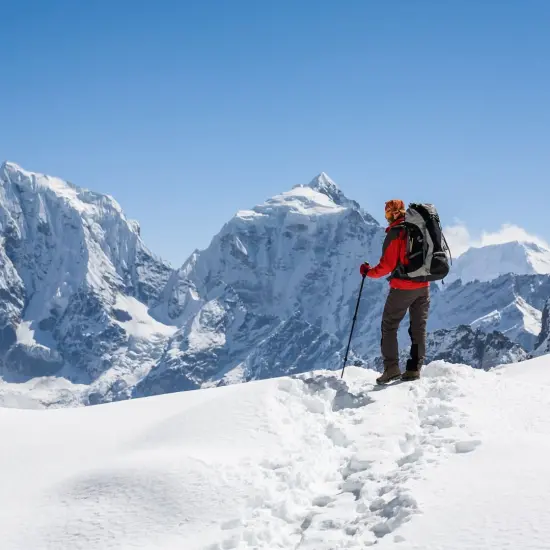The Makalu Base Camp Trek stands as an extraordinary odyssey into the remote eastern Himalayas of Nepal. Distinguished by its pristine wilderness and profound sense of solitude, this expedition offers a unique tapestry of diverse ecosystems, rich local cultures, and the awe-inspiring presence of Mount Makalu, the world's fifth-highest peak. It’s a journey for those seeking an authentic and challenging Himalayan experience away from crowded trails.
Altitudes and Landscapes: A Vertical Traverse Through Nature's Masterpiece
Your adventure commences in the relatively humid subtropical climate of the Arun Valley, specifically around Tumlingtar (approx. 518m / 1,700 ft), known as one of the world's deepest valleys. From this verdant starting point, the landscape undergoes a dramatic transformation as you steadily gain elevation. Initially, the trail winds through lush, humid subtropical forests, punctuated by traditional terraced farmlands and charming local settlements like Num (approx. 1,560m / 5,118 ft) and Seduwa (approx. 1,500m / 4,921 ft). Here, the air is thick with the scents of thriving vegetation, and the constant murmur of flowing rivers accompanies your steps.
As you ascend, the environment shifts into temperate forests (1,500m - 3,000m), characterized by resilient oak, maple, and birch trees, alongside an astonishing variety of rhododendron species. During spring (March-May), these woodlands explode with vibrant colors, creating a magical trekking experience. Tashigaon (approx. 2,100m / 6,890 ft) typically serves as the final permanent village before venturing deeper into the wilderness, marking a significant transition in the trek's character. Beyond this point, human settlements become sparser, and the raw beauty of nature takes precedence.
Above the dense forests, you enter the captivating realm of subalpine and alpine meadows (3,000m - 4,500m). Here, the scenery expands into vast, open pastures, dotted with unique alpine flora and rugged rocky outcrops. Key waypoints like Khongma Danda (approx. 3,500m / 11,483 ft), Dobate (approx. 3,068m / 10,065 ft), Yangri Kharka (approx. 3,557m / 11,670 ft), and Langmale Kharka (approx. 4,410m / 14,468 ft) mark your steady progression through these incredibly scenic, high-altitude landscapes. The trek also involves traversing several high passes, notably Shipton La (approx. 4,230m / 13,878 ft), which offers breathtaking panoramic views of the surrounding Himalayan giants.
The final push towards Makalu Base Camp leads you into high mountain and glacial terrain (above 4,500m). Here, the landscape becomes stark and formidable, dominated by immense rock faces, glacial ice, and patches of snow. This raw, untamed environment is a testament to the sheer power of the Himalayas. Finally, you reach Makalu Base Camp (approx. 4,870m / 15,978 ft), nestled at the foot of the colossal Mount Makalu itself. From this vantage point, the views of Makalu's distinctive pyramidal summit are truly awe-inspiring. On clear days, the panorama expands to include distant glimpses of other legendary peaks, such as Mount Everest (8,848.86m), Lhotse (8,516m), Chamlang (7,319m), and Baruntse (7,129m), creating an unforgettable vista.
Key Landmarks Along the Trail:
Each stage of the Makalu Base Camp Trek is punctuated by significant landmarks, offering unique experiences and views. Tumlingtar (518m) serves as your aerial gateway, from which a scenic drive leads to Num (1,560m), the village where your trekking journey truly begins with a challenging descent and ascent. Further on, Seduwa (1,500m) acts as a crucial checkpoint before entering the national park's core. Tashigaon (2,100m) stands as the last permanent Sherpa settlement, a cultural hub before the wilderness. As you climb, Khongma Danda (3,500m) offers your first expansive high-mountain views, while the crossing of Shipton La (4,230m) provides stunning vistas. Within the pristine Barun Valley, key overnight stops like Dobate (3,068m), Yangri Kharka (3,557m), and Langmale Kharka (4,410m) immerse you in alpine beauty. The trek's ultimate reward is, of course, reaching Makalu Base Camp (4,870m), directly beneath the imposing pyramid of the world's fifth-highest peak.
Permits and Regulations: Navigating the Protected Wilderness
Accessing the Makalu Base Camp Trek requires adherence to specific regulations, as the route traverses the highly protected Makalu Barun National Park. For all foreign trekkers, obtaining the following permits is mandatory:
- Makalu Barun National Park Entry Permit: This permit grants you legal access to the national park's protected areas. The current cost is approximately NPR 3,000 (around USD 30) for foreign nationals.
- Makalu Rural Municipality Permit: This local area permit is essential for trekking within the broader Makalu region and serves as a replacement for the general TIMS (Trekkers' Information Management System) card for this specific route. Its typical cost is around NPR 2,000 (approx. USD 20).
Important Legal Requirement: Mandatory Guide: As per the regulations effective April 1, 2023, all foreign trekkers in Nepal, including those on the Makalu Base Camp Trek, are legally required to be accompanied by a licensed trekking guide. Solo trekking is no longer permitted in any of Nepal's trekking regions. This measure significantly enhances trekkers' safety, provides vital local employment opportunities, and supports responsible tourism practices. Your chosen trekking agency will be responsible for arranging all necessary permits and ensuring you are accompanied by a certified and experienced guide.
Health and Safety: Prioritizing Your Well-being on the Trail
The Makalu Base Camp Trek, being a challenging high-altitude expedition, demands careful attention to health and safety. Foremost among the concerns is Acute Mountain Sickness (AMS), which can range from mild discomforts (headache, nausea, fatigue) to life-threatening conditions like High-Altitude Pulmonary Edema (HAPE) or High-Altitude Cerebral Edema (HACE). Prevention is key: a gradual ascent profile, incorporating adequate acclimatization days, maintaining excellent hydration, and avoiding overexertion are paramount. Should AMS symptoms arise, immediate cessation of ascent is required, and worsening symptoms necessitate rapid descent.
Beyond AMS, your physical fitness is crucial. Prioritize developing robust cardiovascular endurance, significant leg strength, and a stable core through dedicated training for several months before your trek. The mountain weather is notoriously unpredictable, so be prepared for extreme weather fluctuations, including strong winds, intense sun, and freezing temperatures even outside peak winter. Layered clothing is essential for adaptability. Due to the trek's remote nature, medical facilities along the trail are extremely limited or non-existent; thus, emergency helicopter evacuation is typically the sole option for serious medical emergencies. The terrain itself presents trail hazards, including rocky, uneven, slippery, and occasionally exposed sections, requiring constant vigilance from trekkers. Finally, maintaining strict food and water hygiene—consuming only boiled or filtered water and well-cooked meals—is vital to prevent gastrointestinal issues.
Travel Insurance: An Absolute Imperative: Comprehensive travel insurance is unconditionally mandatory for the Makalu Base Camp Trek. Your policy must explicitly cover:
- High-Altitude Trekking: Coverage up to or exceeding the maximum altitude reached (at least 5,000 meters / 16,400 feet).
- Emergency Helicopter Evacuation and Rescue: This is the most critical component, given the trek's remoteness.
- Medical Emergencies and Treatment: Including any altitude-related illnesses.
- Trip Cancellation and Interruption: For unforeseen circumstances.
- Loss, Theft, or Damage to Baggage.
Culture and History of the Makalu Region: A Glimpse into Himalayan Life
The Makalu region, particularly within the Makalu Barun National Park's buffer zone, is a vibrant tapestry of diverse ethnic communities. The Rai and Sherpa people form the predominant populations, alongside smaller groups like the Limbu and Tamang. Their rich cultural heritage offers a unique insight into Himalayan life.
The Sherpa culture, deeply rooted in Tibetan Buddhism, is evident in the ubiquitous chortens (Buddhist stupas), fluttering prayer flags, and local monasteries found throughout their villages. Renowned globally for their mountaineering prowess, Sherpas are equally celebrated for their warm hospitality and profound resilience, living lives intimately connected to the mountains. You'll gain firsthand experience of their traditional way of life during your stays in the local teahouses. The Rai people, indigenous to eastern Nepal, possess their own distinct language and cultural practices, often blending animistic beliefs with elements of Hinduism and Buddhism. They are primarily traditional farmers, skillfully cultivating terraced fields in challenging mountainous terrain.
Historically, the Makalu Barun National Park was established in 1991, forming an eastern extension of the iconic Sagarmatha National Park. This conservation effort, greatly supported by organizations like The Mountain Institute, aimed to protect the region's extraordinary biodiversity. The area's history is also marked by ancient trade routes that once connected Nepal with Tibet, a testament to the enduring presence of its inhabitants who have lived in harmonious coexistence with this formidable Himalayan environment for centuries. This trek offers a privileged opportunity to witness these unspoiled traditional lifestyles, a stark contrast to more commercialized trekking circuits.
Flora, Fauna, and Wildlife: Biodiversity in the Heart of the Himalayas
The Makalu Barun National Park holds a unique global distinction as the only protected area in the world to encompass an elevation gain of over 8,000 meters, stretching from approximately 435m at its lowest point to the summit of Mount Makalu at 8,485m. This extraordinary vertical range fosters an unparalleled diversity of ecosystems, sustaining a breathtaking array of plant and animal life.
The flora within the park is incredibly rich, boasting over 3,000 species of flowering plants. As you ascend, you'll traverse through:
- Subtropical forests: Characterized by species like Sal (Shorea robusta) and other broadleaf trees.
- Temperate forests: Home to oak, maple, birch, and an astonishing 25 out of Nepal's 30 species of rhododendron. In spring, these forests are a riot of vibrant colors.
- Subalpine and Alpine meadows: Adorned with various alpine flowers, grasses, and juniper shrubs, particularly vibrant in areas like the Barun Valley. The park also protects over 47 species of orchids, 19 types of bamboos, 87 species of medicinal herbs, and 56 identified rare plant species.
The park is a critical habitat for a wide array of fauna and wildlife, including several highly rare and endangered species.
- Mammals: Trekkers might spot the elusive snow leopard, the endearing red panda (a particular highlight for many), Himalayan tahr, musk deer, Himalayan black bear, clouded leopard, ghoral, barking deer, wild boar, and various primate species.
- Birds: With over 400 recorded bird species, Makalu Barun is a true paradise for birdwatchers. Keep an eye out for high-altitude species like the Himalayan monal (Nepal's national bird), blood pheasant, various eagles, vultures, and a plethora of other resident and migratory birds.
- Beyond mammals and birds, the park's biodiversity extends to 43 species of reptiles, 16 species of amphibians, and over 315 species of butterflies. The Arun River itself, which you'll cross early in the trek, supports an impressive 78 species of fish.
The Makalu Base Camp Trek is much more than a physical challenge; it's an immersive journey through one of the planet's most biologically rich and culturally vibrant high-altitude wildernesses.
Ready to explore the untouched beauty of the Makalu region? Contact us today to plan your unforgettable Makalu Base Camp Trek adventure!






























































